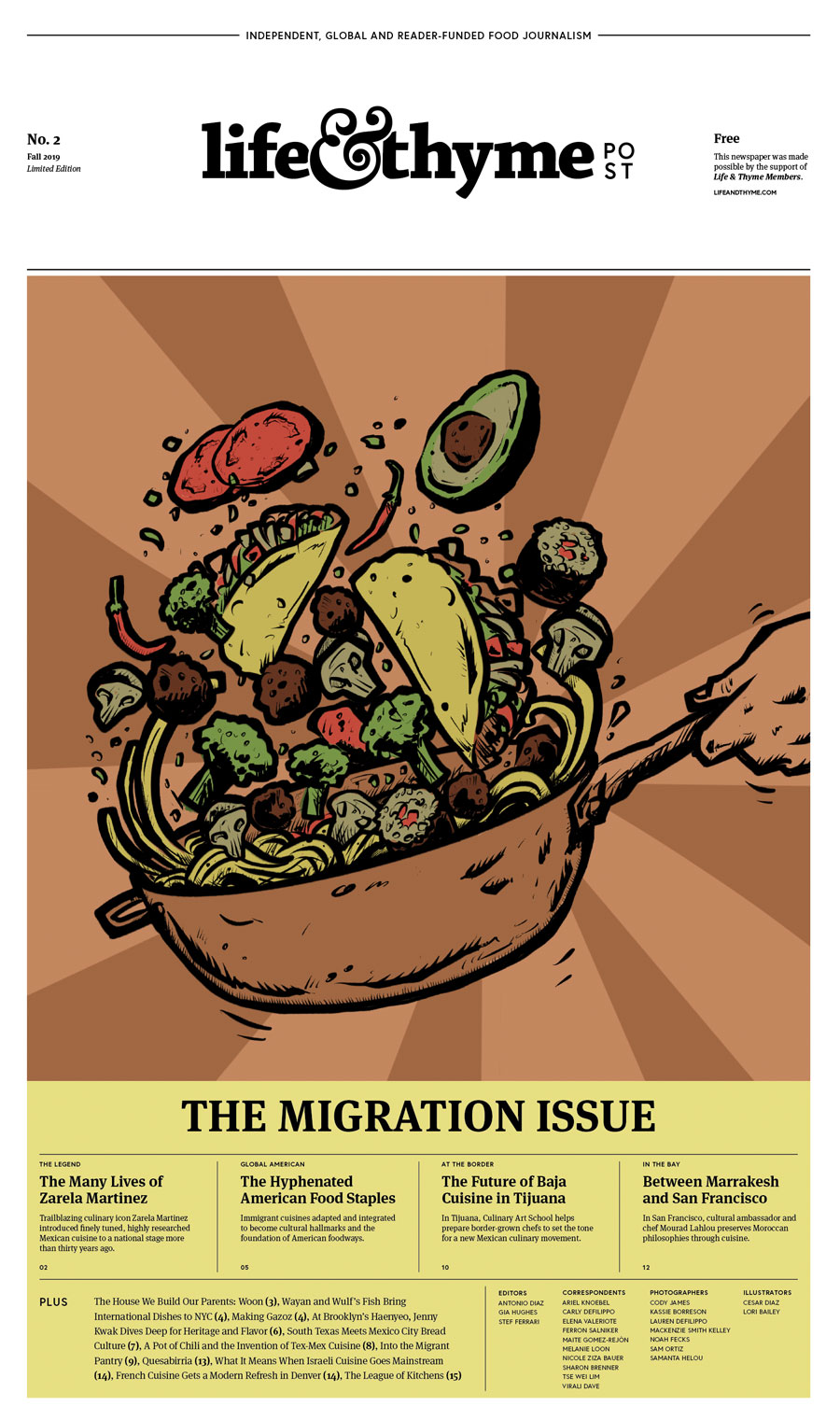
This story can also be found in The Migration Issue of Life & Thyme Post, our limited edition newspaper for Life & Thyme members.
Off the small island of Jeju in South Korea, a group of female divers known as the Haenyeo (or sea women) commit every ounce of their focus to the waters and aquatic ecosystem of the Korea Strait. Such diligent attention is necessary, because their work is not your average fishing day at the beach; it is an intensive, life-threatening harvest mission. The Haenyeo spend up to seven hours every day plunging into the frigid waters up to ten meters without oxygen masks or other safety gear. They scour for sea urchin and abalone, among other sea life, armed only with a small knife, traditional prayers to the goddess of the sea, and sheer determination. They are categorized by experience level, with respected elder divers aged well into their eighties, looked to for guidance and mentorship by younger generations.
So integral to the culture is this group and their practice that in 2016 the Haenyeo were inscribed into the UNESCO Representative List of the Intangible Cultural Heritage of Humanity. There is evidence of this custom as far back as the seventeenth century, although there is belief the Haenyeo has been diving far longer than that.
Jenny Kwak has been doing her work for twenty-seven years, since she was nineteen. That’s when she left Parsons University where she was pursuing a degree in art, to join her mother in wading into the uncharted waters of restaurant operation.
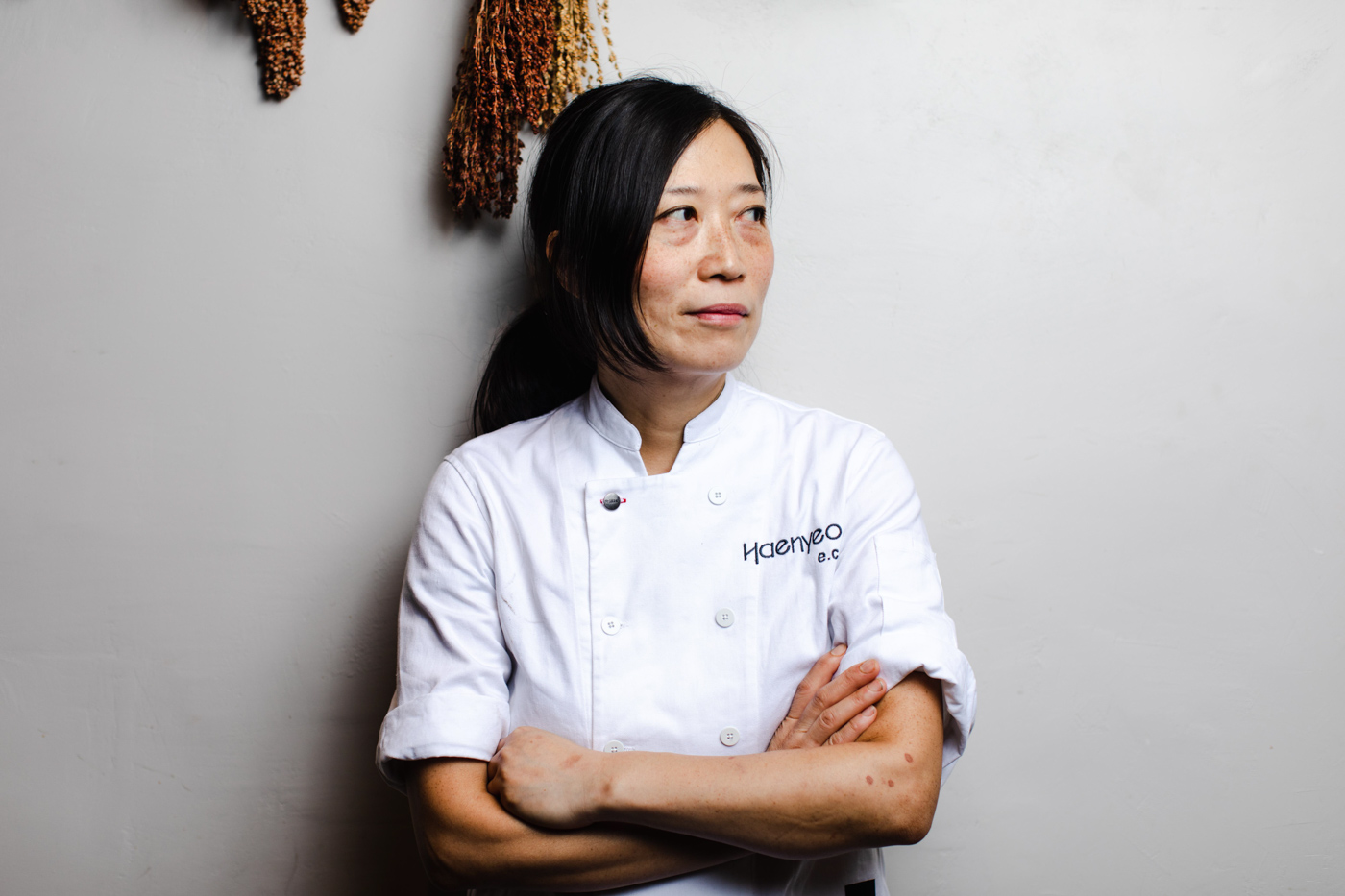
Her classes were expensive, and she says, “It became too hard; I thought I should just really work.” This move suited the creative young Kwak just fine. “It was at a time that New York City just felt so fascinating to me—the culture and lifestyles and music and fashion. I became more interested in hanging out in the East Village instead of going to school,” she says.
As the eldest child, she also felt a responsibility to help her family, and shared with her mother an idea as to how. “I said, ‘I want to work, let’s open a restaurant,’” Kwak remembers. Even then, she was motivated by memories. “Being in college and away from home, I always missed [my mother’s] cooking. I thought if I missed it, other Korean people would too.” Her childhood, she says, was representative of the common “immigrant lifestyle.”
“My parents arrived [in the U.S.] with $500. My mother had always [worked in] a lot of small businesses; she always worked so hard.” Kwak recalls that like many immigrant families, the time they were able to spend together was over their evening meal. “It was dinner time that was always very special; [my mother] always made really great meals,” she says. “A lot of my fond memories growing up were based on food; it was really the only time she had for her children.” Despite the fact that neither had restaurant experience, it was with this in mind that Kwak worked to sell her mother on the food industry.
The idea was initially rejected—at least, that’s what Kwak thought. “I didn’t think she was taking me seriously, but it turns out she was scoping out places in the East Village at night,” says Kwak. More than twenty-five years later, she sets the scene for me: the East Village in 1992, not exactly a place most people wanted to spend their hours after dark.
Yet that’s exactly where her mother decided to place their first bet, and Dok Suni was born. “We didn’t know what we were doing. All I knew is the food was good and I was determined to get people to try it,” Kwak says of the restaurant. In the beginning though, that wasn’t enough. “We’d bring in $70 and end up in tears wondering what we did.”
Fortunately, Kwak says word of mouth eventually reached the press. “A year after we were open, a New York Magazine writer came in. She did a writeup on us about my mother’s pork ribs, and it just took off after that,” she says. Seven years later, they opened a second restaurant, Do Hwa, in the West Village. In the time between, Kwak did a stint at the French Culinary Institute (now International Culinary Center), and even wrote a cookbook after a customer who happened to be a literary agent approached her. She also started her own family, which began to change the way she viewed her work. “I got married and had my daughter,” she says. “When you start having children, one gets more curious about cooking.”
After twenty very successful years in the Manhattan dining scene, leases were coming to an expiration, and Kwak saw the opportunity for a change of lifestyle. “I was looking for something smaller and easier, [where you’re] able to enjoy the food you’re cooking versus the everyday knock-it-out kind of thing.” She found a space across the river in Brooklyn, which she felt would allow her those freedoms. “I ended up in Park Slope because it’s family-oriented and calm. I wanted to close early. I was coming from the West and East Village, with younger crowds in the city. I just wanted a slower pace.”
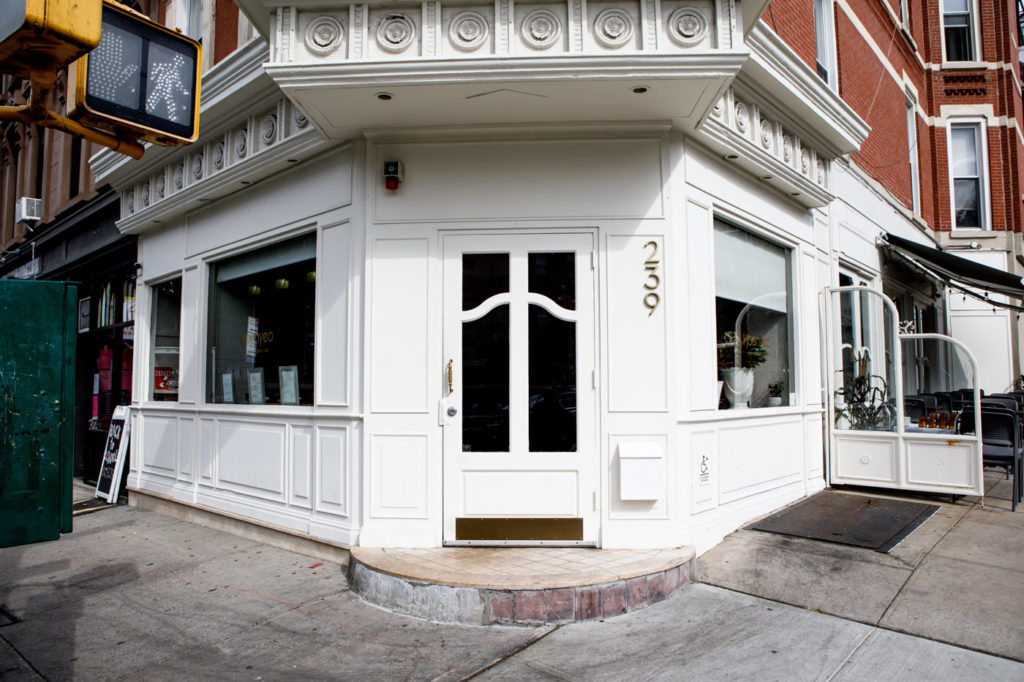
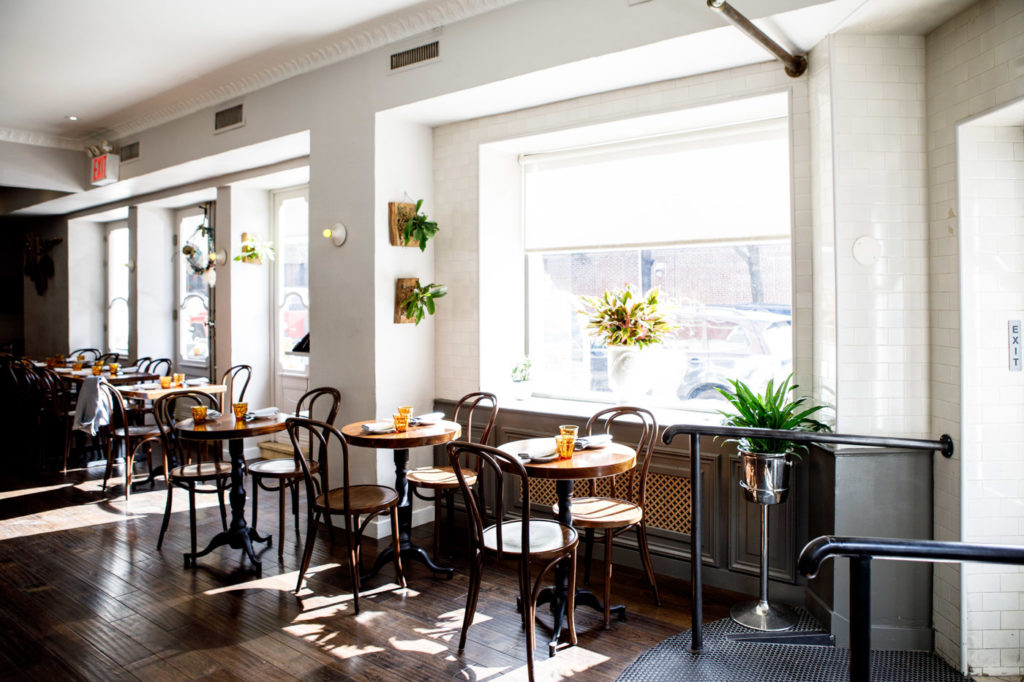
In a nod to their legacy, she landed on the name Haenyeo because, she says, “there was always a matriarchal symbol in our restaurant.” Dok suni, she tells me, means strong women. “In my family, it was always the women who carried the load, so it was fitting for us—for my mother and I—to name it that.”
Although she wanted to honor that tradition, Haenyeo was also an opportunity to reinvent herself culinarily. The menus at Dok Suni were representative of her mother’s life and experience. “That was her kitchen. She was the boss. With this restaurant, I’m taking over the kitchen,” Kwak says. “It’s not just the traditional Korean dishes. It’s food I enjoy making.”
What Kwak has developed for Haenyeo runs the gambit, but the common thread is a representation of her own experience as a Korean-American. “I didn’t grow up in Korea; I feel like I’m a little bit more American than Korean at times. Culturally, there are different ways to do things,” she says, but cites the common core between the two worlds, which is “always about sharing food.”
In that spirit, when I visit Haenyeo for a meal, I invite a few friends. When we’re first seated at a four-top in the bright dining room, we reflect on the feeling of family in every inch of the space. In fact, when Kwak approaches to introduce herself, she gestures to the outdoor patio where her husband, her daughter, and family friends are enjoying their own evening together.
“My friends are a lot like me,” Kwak says. “All Koreans who grew up here—that’s who I was trying to attract. They always say to me, ‘That’s just how my mom makes it,’” she says. The presence of family at the restaurant is not only in their physical reality, but in culinary cues. If you’re tuned in, you can see traces of her husband’s upbringing—he was raised in New Orleans—especially the ethereal beignets, which arrive after dinner dusted with powdered sugar that melts into a sweet, sticky glaze on the still-warm pastry, or in the grilled oysters with brioche toast.
Overall, Kwak’s menu reads as a personal account of a Korean woman in a multicultural world. One of the breakout dishes, with practically its own Instagram following, is the “saucy and spicy rice cake fundido with chorizo,” which Grub Street described as being “Korean, Mexican, Spanish, Swiss, and maybe even a little Japanese, all at once.” The dish is both playful and thoughtful, and you can almost see the wheels turning in Kwak’s culinary mind with each bite. A bed of chewy, al dente tteokbokki rice cakes smothered in sweet and spicy gochujang, melty Oaxaca cheese, and salty sausage, topped with crunchy jalapeño—it’s nearly impossible to stop eating.
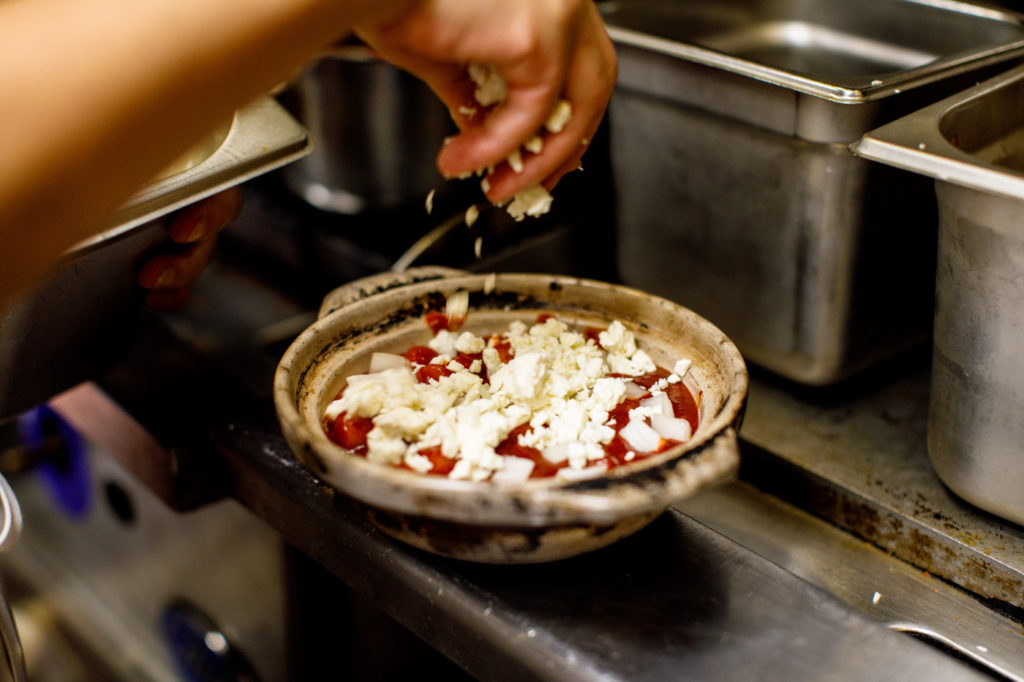
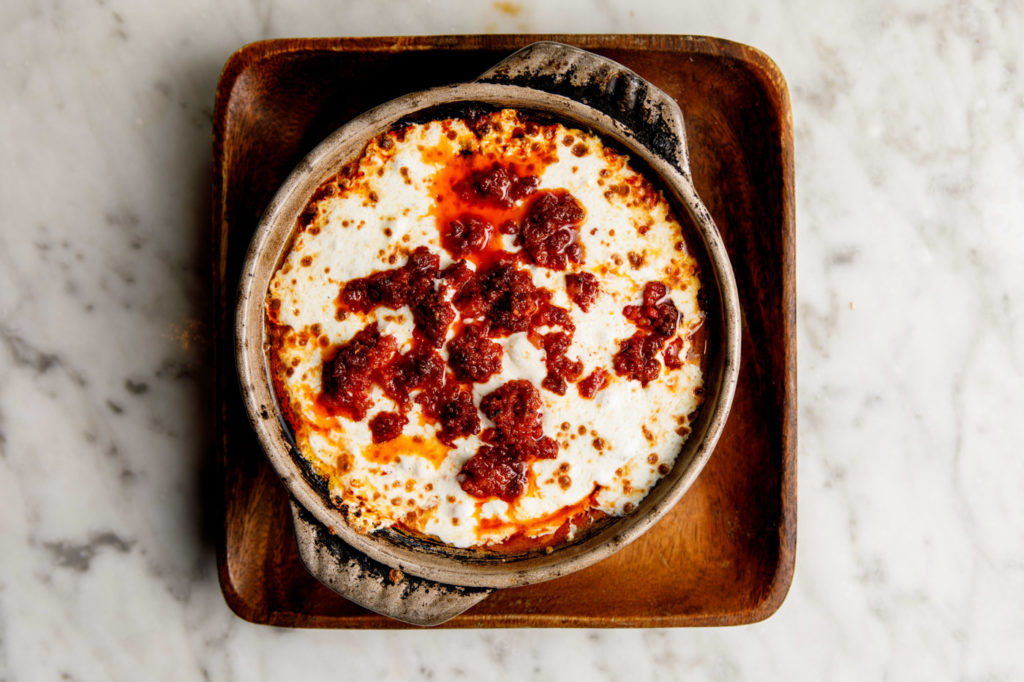
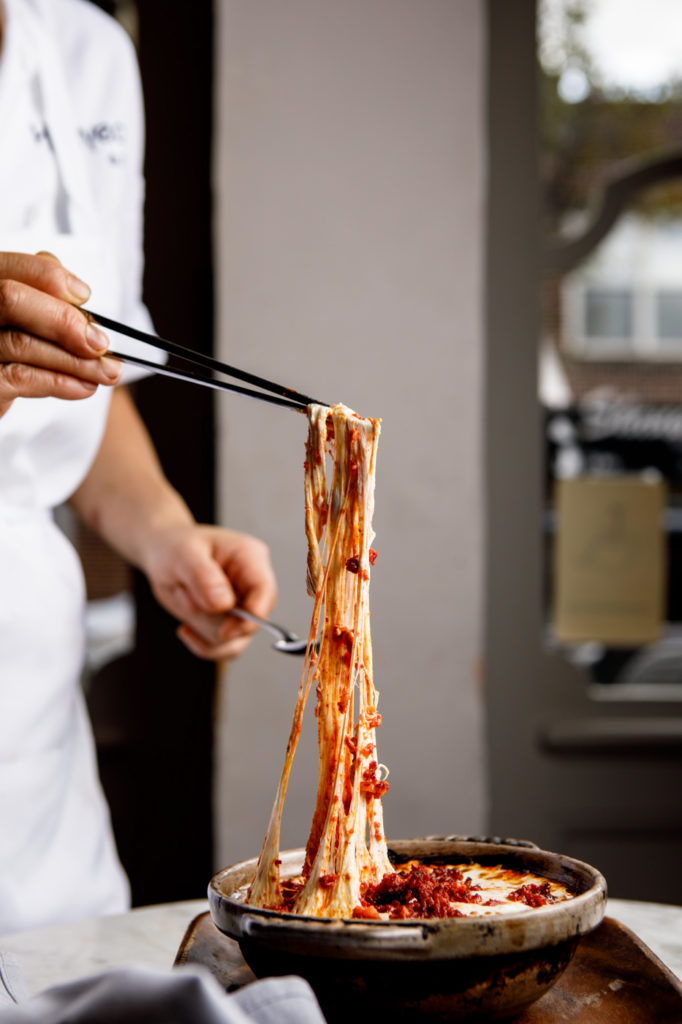
But her willingness to dabble in other cultural stapes doesn’t mean she’s abandoned the flavors of her own. In fact, she sees an opportunity with Haenyeo to help change the conversation about what Korean food is for a new generation, much the way her mother did decades ago. “I think a lot of people feel Korean food is not so based on fresh food.” Kwak believes that many diners associate a heavy use of sauces or pungent flavors as compensation. “I thought people thought that’s why Korean food was so heavily spiced to make up for it not always being fresh. It’s a very bad stereotype.” It was also not her own experience. “I always grew up eating very fresh food that my mother prepared. My main goal with this restaurant was to use a lot of fresh seafood and vegetables and meat and prepare it like real homestyle.”
That said, Park Slope isn’t home to a particularly strong population of Korean immigrants who would recognize that style. “My intention was always to bring Korean food to the Western markets, not to Koreans. I’ve never been located in a heavily Korean populated neighborhood. It’s always been about who I am and what kind of crowd I connect with,” she says. “I don’t think I could last on 34th Street [in New York’s Koreatown] or cooking for the Korean community.”
While the Haenyeo inspired the spirit of the restaurant, Kwak says the menu doesn’t directly mirror that of Jeju Island. “[The food on Jeju Island] is a lot of raw fish; it’s very simple, very basic, steamed and dipped in a chili sauce.” She felt that style of cuisine might not appeal to the American palate.
But plenty of seafood dishes do appear at Haenyeo, and an especially dramatic one arrives on our table in the form of French-style bouillabaisse. The bowl can barely contain the shrimp, mussels, clams and cod, all crowned by a whole crab. “I have a love for any kind of seafood soups,” Kwak says. “The bouillabaisse is one of the biggest sellers here and I try to marry what I like as a Korean, spice, and the French technique of cooking it. It’s familiar to Koreans because of the spice and the fresh seafood flavor, and we serve that with baguette toast.” That toast just so happens to be smothered with seaweed butter—perhaps not traditional to the French preparation, but is instead an honoring of the restaurant’s namesake. “I tried to take inspiration from Jeju Island,” Kwak says. “They love their seafood with the flavor of the sea.”


The essence of the Haenyeo, in fact, is everywhere in the restaurant, even visually represented in a series of striking portraits of these legendary women against white walls. And the tribute is about more than the culinary heritage. “It’s not so much about the food from Jeju Island, but more about what these women represent for us. Their line of work is life or death; it’s not like they have any safety system with the diving,” Kwak says. “A lot of them die in the water. [It’s about] what it takes to survive.”
The discipline with which a restaurant must be run to survive can be inspired by the will of the Haenyeo. “You have to be thick skinned and persistent to operate a restaurant and keep doing it,” Kwak says of the business. “I feel like it’s just about determination and doing something good. That’s why these women mean a lot to me.”
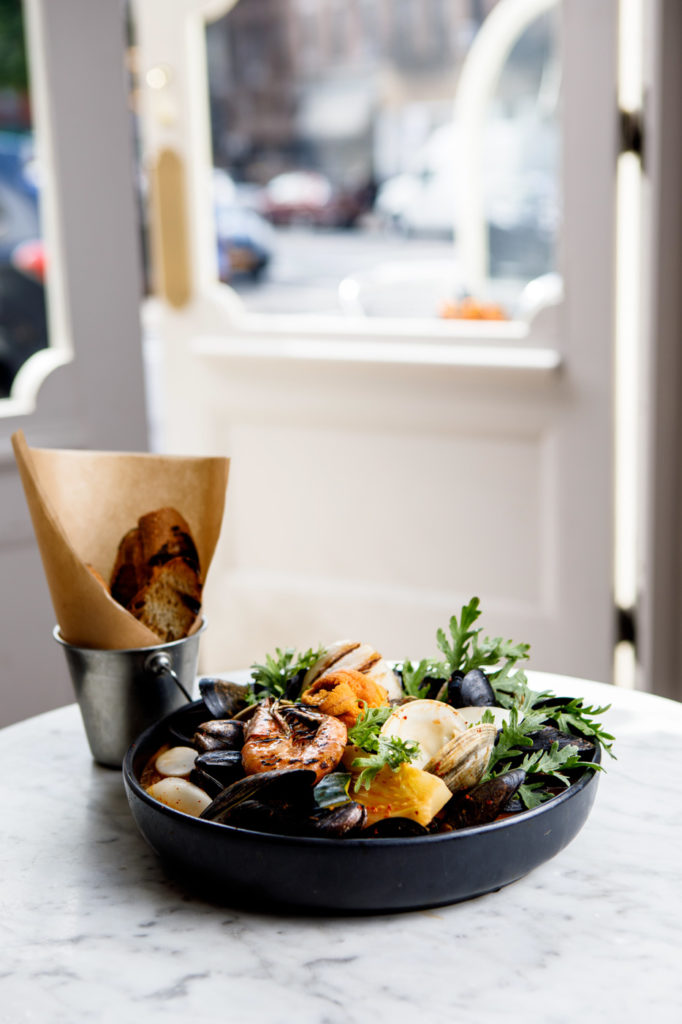
It is impossible to talk about the Haenyeo without a discussion of survival, of the risks these Korean women take every day to do their job, to carry on a culture and legacy, and to provide for their families and communities. For Kwak, it’s a philosophy that means protecting her own culture and a legacy she began with her own mother. At Haenyeo in Brooklyn, inspiration has been passed through generations and between family members. It comes from across the river and the globe, evident in the sharing of culture—and craveable, inventive food—around each and every table.







Our comments section is for members only.
Join today to gain exclusive access.